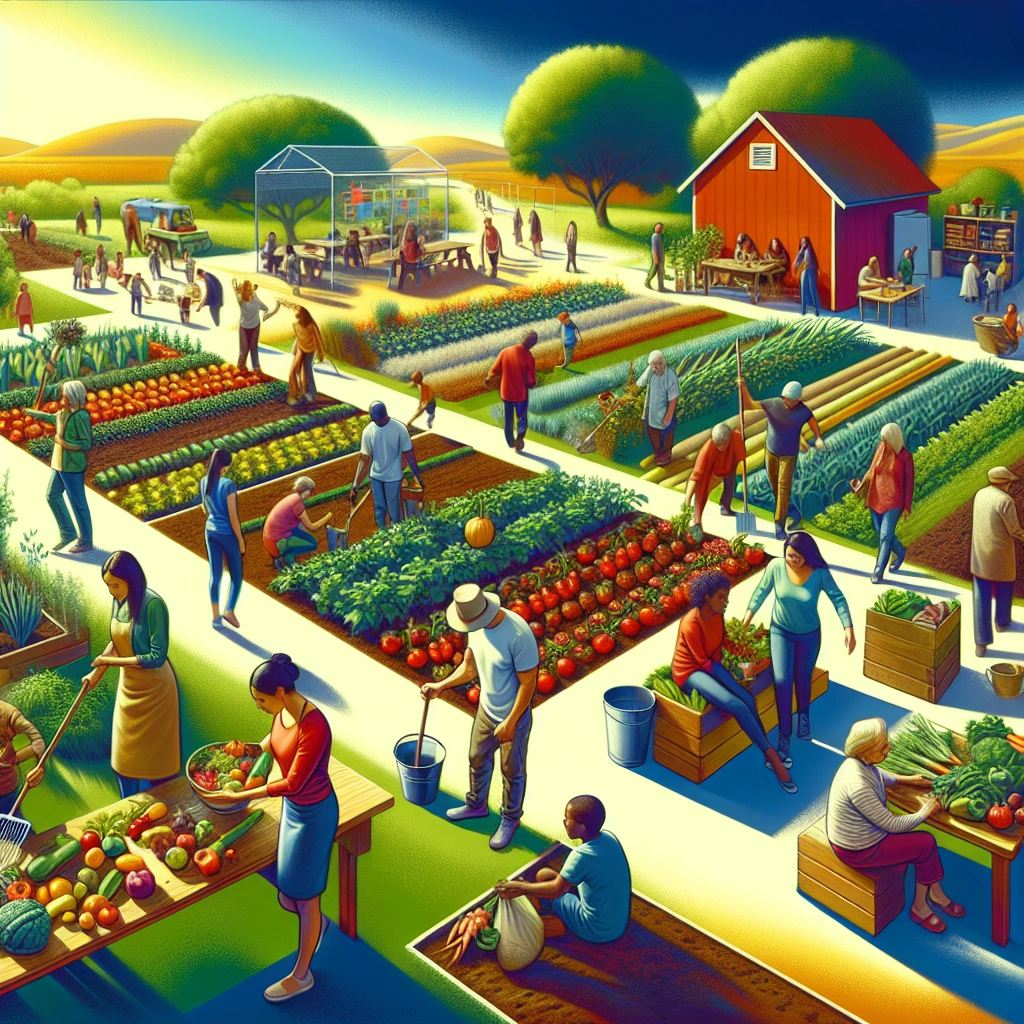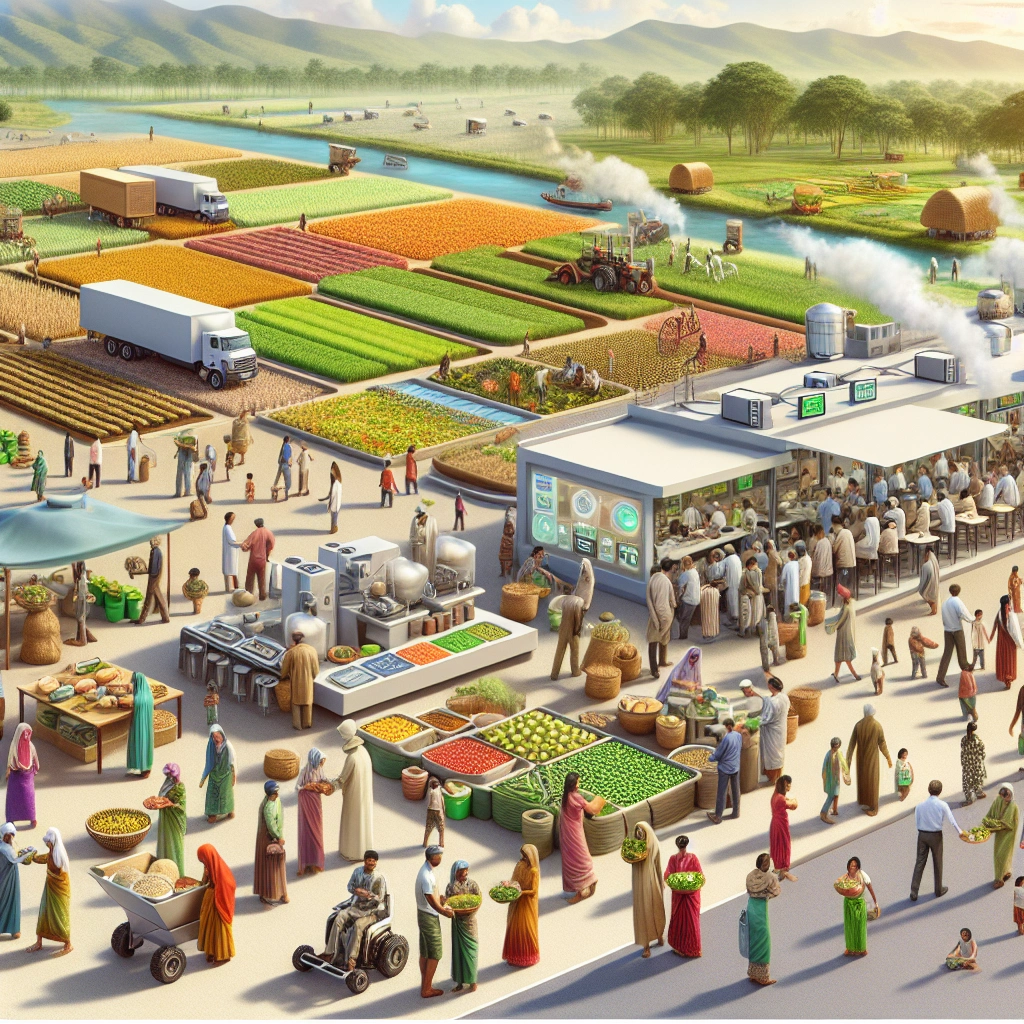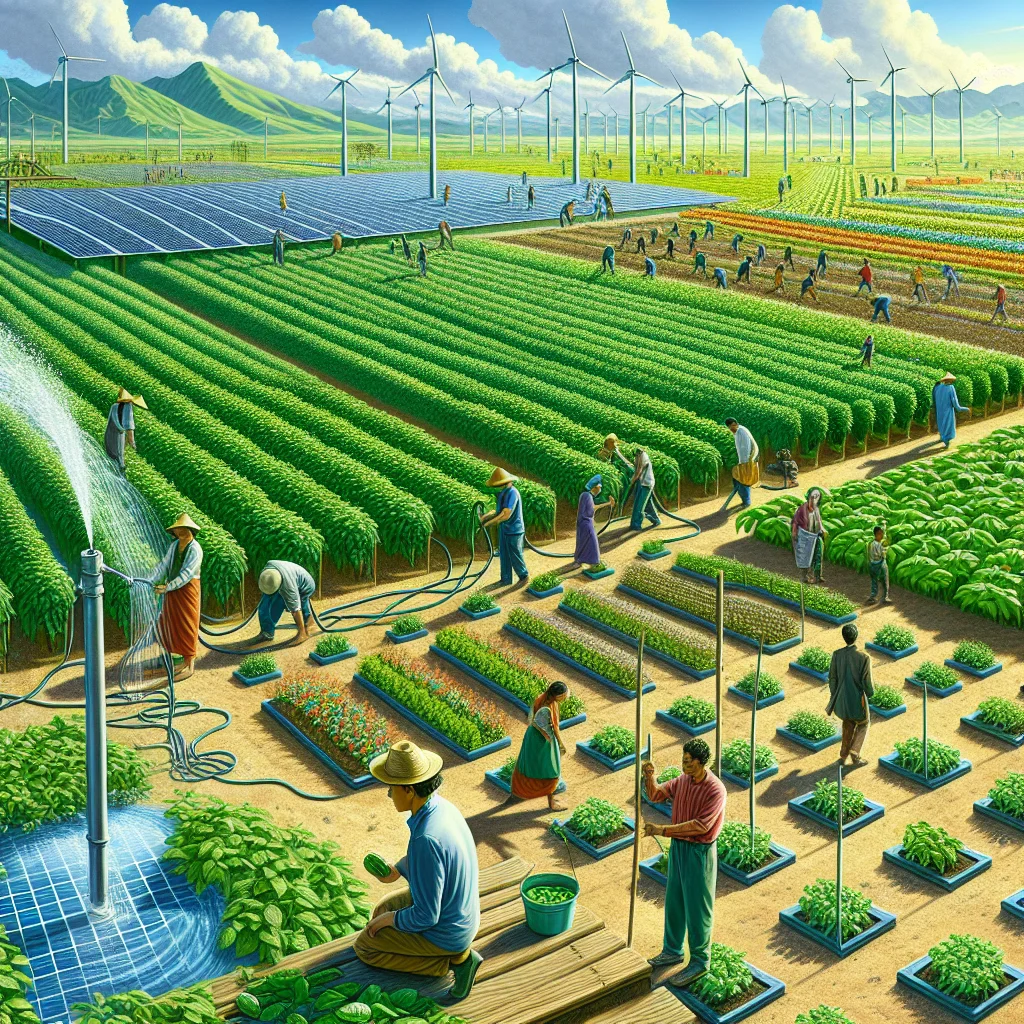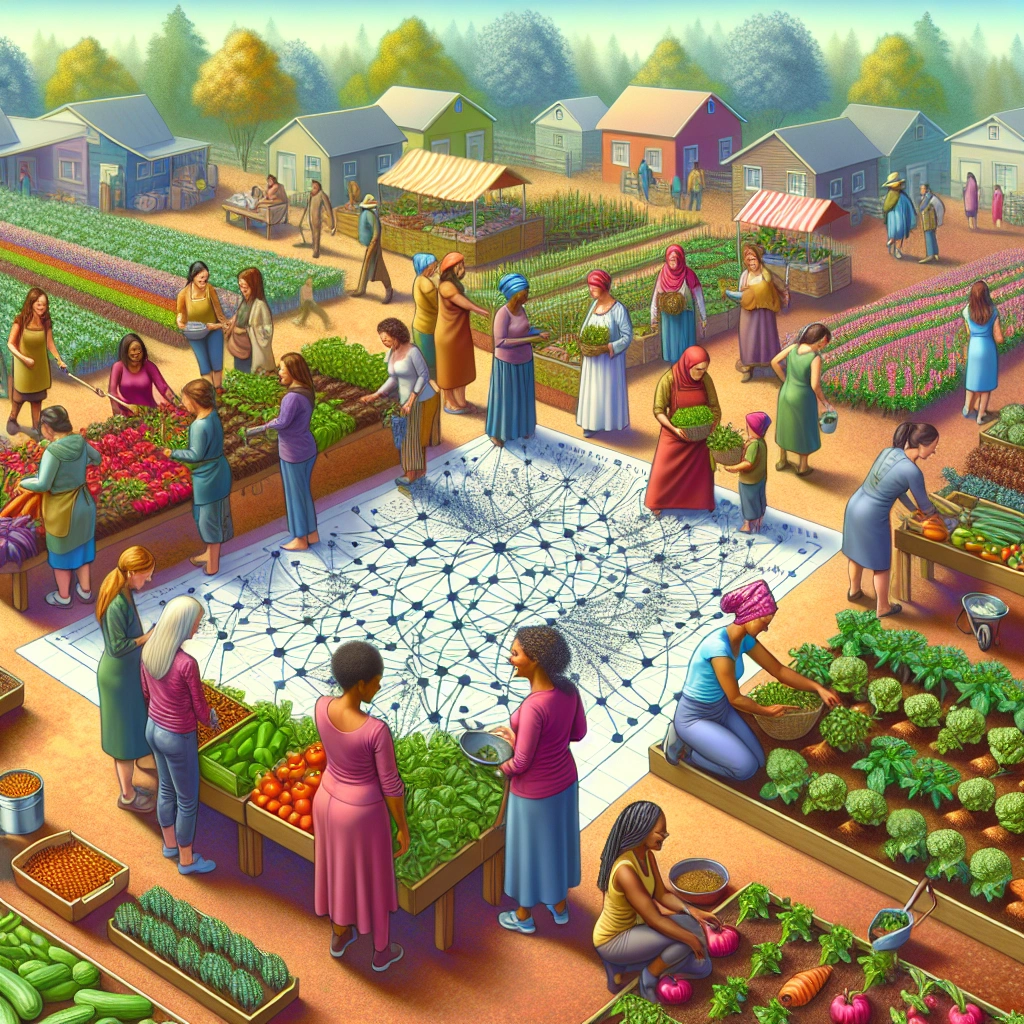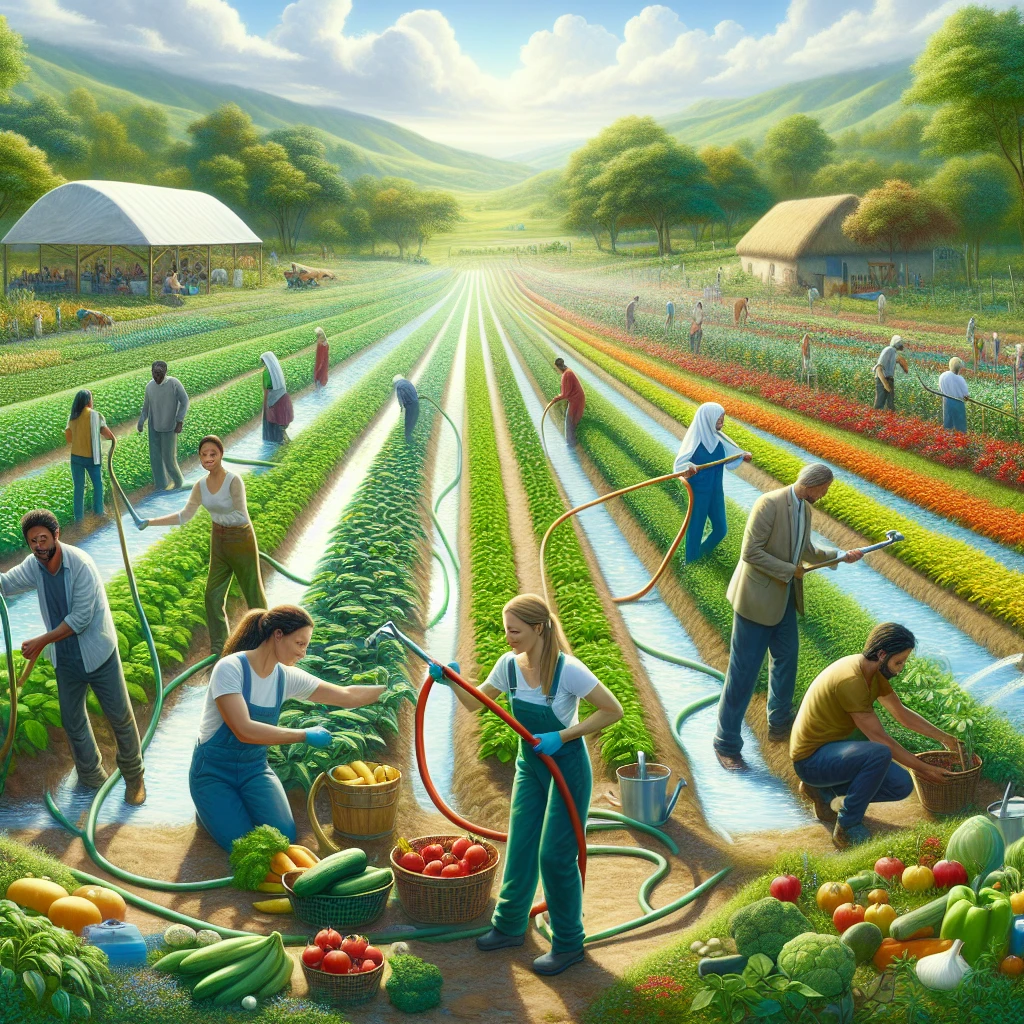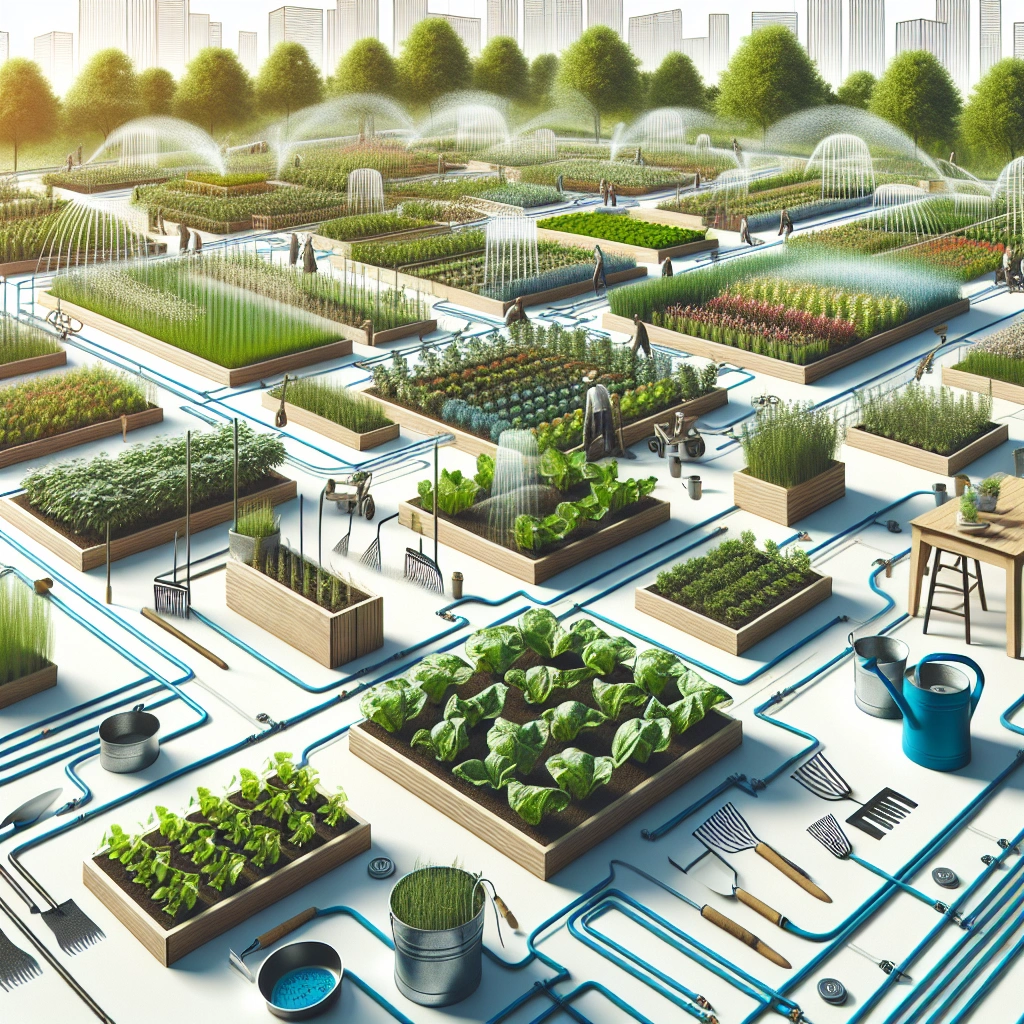

Food security is the state of having reliable access to a sufficient quantity of affordable, nutritious food. Interventions to improve food security are crucial in addressing the underlying causes of food insecurity, such as poverty, unemployment, and inconsistent access to healthy food.
This article will focus on effective strategies and interventions that can be implemented to improve food security and ensure that everyone has access to an adequate and healthy food supply.
Check out this Youtube video: Learn about interventions to improve food security and the effects of food systems interventions on food security.
Understanding Food Insecurity
Definition of food insecurity
Food insecurity refers to the state of being without reliable access to a sufficient quantity of affordable, nutritious food. It is not just about hunger, but about the lack of consistent access to food that promotes a healthy lifestyle.
This condition can affect individuals and households, leading to detrimental impacts on their overall well-being.
Factors contributing to food insecurity
Various factors contribute to food insecurity, including poverty, unemployment, lack of access to affordable nutritious food, and inadequate public assistance programs. Additionally, systemic issues such as racial and ethnic disparities, as well as disability and income inequality, play a significant role in exacerbating food insecurity in communities.
Impact of food insecurity on individuals and communities
The impact of food insecurity extends beyond hunger, affecting individuals’ health, productivity, and overall quality of life. Food insecurity can lead to severe health issues, hinder children’s growth and development, and increase the risk of chronic diseases.
At the community level, it can perpetuate cycles of poverty and inequality, hindering the overall socio-economic progress and well-being of communities.
| Category | Impact |
|---|---|
| Health | Severe health issues, increased risk of chronic diseases |
| Children | Hinders growth and development |
| Community | Perpetuates poverty and inequality |
Interventions to Improve Food Security: Policy and Governance
Role of government policies in addressing food security
The role of government policies in addressing food security is pivotal, as it sets the framework for alleviating hunger and ensuring access to nutritious food. Through initiatives like subsidies for agricultural inputs and price stabilization mechanisms, governments play a key role in ensuring food production and availability for their citizens.
Additionally, social safety nets and nutrition assistance programs are vital in safeguarding vulnerable populations against food insecurity.
Examples of effective policy interventions
One effective policy intervention is the implementation of food price stabilization mechanisms to ensure affordability and accessibility of essential food items. Another example is the establishment of community-based food programs that aim to empower local communities in sustaining food security.
Furthermore, investment in agricultural infrastructure and technology can significantly boost production and distribution efficiency, strengthening food security.
The interaction between governance and food security
The interaction between governance and food security is intricately linked, as effective governance ensures the implementation and enforcement of policies that directly impact food production, availability, and access. Additionally, transparency and accountability in governance are essential to safeguarding food security initiatives and resources from corruption and mismanagement, thereby ensuring their effective utilization to address food insecurity.
| Government Policy | Impact on Food Security |
|---|---|
| Agricultural subsidies | Enhances production and affordability |
| Social safety nets | Safeguards vulnerable populations |
| Price stabilization | Ensures accessibility of essential food items |
These examples highlight the crucial role of government policies and governance in shaping and sustaining food security, ultimately contributing to the well-being of individuals and communities.
Interventions to Improve Food Security: Agricultural Development
Importance of sustainable agricultural practices
Sustainable agricultural practices are crucial for enhancing food security by ensuring the long-term production of nutritious foods. By preserving soil fertility and reducing environmental impact, sustainable methods lead to higher yields, benefiting both farmers and consumers.
For example, crop rotation and embracing diversity can promote healthier soil and better pest control, contributing to sustainable agriculture’s role in improving food security.
Examples of agricultural interventions for improved food security
Agricultural interventions play a vital role in enhancing food security. By focusing on input subsidies, soil improvement, and crop diversification, these interventions can directly impact food availability and access.
Moreover, community-based participatory interventions, which involve agricultural education and support for gardening, have shown positive outcomes in addressing local food security issues. Additionally, urban agriculture innovations, such as intensive production strategies and soil rehabilitation, contribute to ensuring a consistent supply of fresh and culturally appropriate foods, especially in urban areas.
Encouraging small-scale farming and community gardens
Small-scale farming and community gardens significantly contribute to food security by enhancing food availability and access. These initiatives empower small-scale farmers and gardeners, capacitating them to produce nutritious foods and influence city design to provide greater access to arable land for food production.
Promoting home gardens and community gardens can lead to multiple social benefits, including improved food and nutritional security, offering a promising approach to address food insecurity at the household level. The phrase “Small-scale producers feed the nation” truly reflects the vital role of small-scale farming in prioritizing food production and promoting rural enterprise growth.
Interventions to Improve Food Security: Nutrition Education
Educating communities about balanced diets and nutrition
To address food security, educating communities about balanced diets and nutrition is critical. By providing workshops and seminars on the importance of including diverse food groups in daily meals, individuals can gain a deeper understanding of the nutritional value of different foods.
For example, explaining the benefits of incorporating leafy greens, lean proteins, and whole grains into their diets can empower communities to make healthier food choices.
Programs for teaching food preparation and cooking skills
Implementing programs for teaching food preparation and cooking skills is also essential. For instance, offering cooking classes that emphasize healthy cooking techniques and affordable ingredient options can equip individuals with the practical skills needed to prepare nourishing meals at home.
This approach not only promotes healthier eating habits but also empowers individuals to take control of their food choices, contributing to long-term food security.
Addressing the root causes of malnutrition
Addressing the root causes of malnutrition requires a multifaceted approach. This can involve initiatives such as community gardens to increase access to fresh produce, advocating for policies that support local food production, and raising awareness about the importance of regular meals for overall health.
By addressing these root causes, we can create sustainable solutions that positively impact food security and mitigate the risk of malnutrition within communities.
| Benefits of Nutrition Education |
|---|
| Empowers individuals to make healthier food choices |
| Equips communities with practical cooking skills |
| Addresses root causes of malnutrition |
| Promotes long-term food security |
By prioritizing nutrition education, we pave the way for healthier, more secure communities and individuals.
Remember, a well-informed community is a stronger community!
Interventions to Improve Food Security: Community Support Programs
Creating food banks and community kitchens
Creating food banks and community kitchens is crucial in addressing food insecurity. These initiatives provide immediate support to individuals and families in need by offering access to nutritious meals and groceries.
For example, Feeding America, with its 200 member food banks, has played a significant role in improving food security by providing essential resources to those facing hunger. Additionally, the utilization of food pantries increased from 4.4% in 2019 to 6.7% in 2020, emphasizing the growing reliance on such support systems.
Engaging in food rescue and redistribution programs
Engaging in food rescue and redistribution programs is an effective strategy to prevent food waste and ensure surplus food reaches those in need. By redirecting safe and high-quality food that would have otherwise been wasted, organizations can contribute to alleviating food insecurity.
The 2019 Food Recovery Challenge National Award highlighted success stories in reducing waste, demonstrating how innovative policies and approaches have significantly contributed to addressing food insecurity.
Promoting community initiatives for better access to food
Promoting community initiatives for better access to food involves identifying and leveraging existing resources to support healthy food access, production, and distribution. For instance, engaging the community to understand food needs is essential for developing tailored interventions.
Moreover, initiatives like community food projects have been successful in addressing food insecurity by promoting activities such as entrepreneurial food and agricultural projects, youth/school gardening, and local food distribution.
| Success Indicators | Percentage |
|---|---|
| Food access and outreach | 62% |
| Entrepreneurial food and agricultural activity | 50% |
| Youth/School gardening or agriculture project | 50% |
| Local food distribution | — |
Community support programs play a pivotal role in interventions to improve food security. By establishing food banks and community kitchens, engaging in food rescue and redistribution programs, and promoting community initiatives for better access to food, substantial progress can be made in addressing food insecurity and ensuring that individuals and families have access to nutritious meals and essential resources.
Interventions to Improve Food Security: Technology and Innovation
Implementing technology for efficient food distribution
Implementing RFID tracking technology in food distribution enhances traceability and quality control throughout the supply chain. For instance, RFID tags and readers enable manufacturers to track products’ location and condition, ensuring optimal handling and minimizing spoilage.
Additionally, temperature sensors play a crucial role in preventing quality deterioration, safeguarding the integrity of perishable goods during transportation and storage.
Using innovation for food preservation and storage
Innovative solutions such as Ovie Smarterware and Apeel Sciences’ “second skin” for fruits and veggies are revolutionizing food preservation. These technologies aim to reduce food waste by extending the storage life of perishable items through controlled environmental modifications and protective coatings.
Moreover, Winnow’s AI tools and TotalCtrl’s inventory management platform offer efficient ways for reducing food waste in commercial kitchens and restaurants.
Addressing food wastage through technological solutions
Technological advancements like Winnow Vision and the Flashfood app are actively combating food wastage in various stages of the food supply chain. Winnow Vision’s AI technology enables automated food waste tracking, while the Flashfood app connects consumers with discounted products nearing their best-by date, reducing the volume of unsold and wasted food in supermarkets.
| Technology | Application |
|---|---|
| RFID Tracking | Product traceability and quality control |
| Temperature Sensors | Preservation of perishable goods during transit |
| Ovie Smarterware | Extended storage life for food items |
| Apeel Sciences | Protective coatings for fruits and veggies |
By leveraging these technological interventions, the food industry is moving towards a more efficient and sustainable approach to food security.
Interventions to Improve Food Security: Climate Change Adaptation
Understanding the impact of climate change on food security
Climate change has a significant impact on food security, leading to increased challenges in food production and availability. The rising global temperatures, extreme weather events, and changing precipitation patterns directly affect crop yields and livestock productivity, posing a threat to food supplies.
For example, heatwaves and droughts can reduce crop production, while heavy rainfall can lead to soil erosion, affecting agricultural land. These changes create food insecurity and increase the vulnerability of communities, especially in low-income countries.
Implementing strategies for climate-resilient agriculture
To address the challenges posed by climate change, implementing climate-resilient agricultural strategies is crucial. Farmers can adopt practices such as diversified cropping systems, no-till farming, and improved soil health management.
For instance, integrating cover crops into farming practices helps enhance soil fertility and reduces erosion, contributing to greater climate resilience. Additionally, utilizing adaptive technologies, such as precision agriculture and sustainable intensification, can optimize resource use and mitigate the impact of climate-related risks on farming operations.
Building sustainable food systems in the face of climate challenges
Building sustainable food systems is essential to ensure food security amidst climate challenges. It involves promoting a holistic approach that encompasses food production, distribution, and consumption while considering environmental sustainability and social equity.
For example, transitioning to agroecological farming methods and promoting local food supply chains can contribute to resilient and sustainable food systems. By enhancing resilience in food production and promoting equitable access to nutritious food, sustainable food systems play a crucial role in addressing the impacts of climate change on global food security.
Interventions to Improve Food Security: Global Collaboration
Importance of international cooperation for global food security
International cooperation is crucial for addressing global food security challenges. By fostering partnerships and collaborations across nations, we can leverage a diverse range of expertise and resources to tackle issues such as food shortages, malnutrition, and agricultural sustainability on a global scale.
This collective effort allows us to pool knowledge and best practices, resulting in more effective solutions to enhance food security worldwide.
The role of international organizations in addressing food insecurity
International organizations play a pivotal role in addressing food insecurity by orchestrating coordinated initiatives and interventions at a global level. Entities like the World Food Programme, Food and Agricultural Organization, and the World Bank are pivotal in providing humanitarian assistance, supporting food production and trade, as well as facilitating sustainable food security programs.
Their expertise and reach enable them to make impactful contributions towards alleviating food insecurity across the globe.
Examples of successful global collaborations in improving food security
One notable example of successful global collaboration in improving food security is the partnership between USDA, USAID, and various international entities to avert the failure of wheat harvests due to the threat of wheat stem rust. This collaboration, which involved universities and partners worldwide, demonstrates the effectiveness of pooling resources and expertise to overcome significant agricultural challenges.
Additionally, the public-private partnership (P3) has been instrumental in using market mechanisms to enhance agri-food systems, thereby contributing to the reduction of food insecurity globally.
| Collaboration Initiative | Contributing Entities | Achievement |
|---|---|---|
| Wheat Stem Rust Prevention | USDA, USAID, global partners | Averted widespread failure of wheat harvests |
Global collaboration and international partnerships are fundamental in addressing food security challenges, with various successful models and initiatives showcasing the efficacy of unified efforts in combating global food insecurity.
Interventions to Improve Food Security: Empowering Women and Gender Equality
The connection between gender inequality and food insecurity
The link between gender inequality and food insecurity is undeniable. Global data from sources like the FAO and CARE highlight a stark connection, with women and girls disproportionately affected by hunger.
A key example is the FAO’s estimation of nearly 1 billion undernourished people, where women bore a disproportionate burden.
Programs empowering women for better access to food resources
Numerous programs are striving to empower women for improved access to food resources. The U. N. World Food Programme, for instance, equips women with essential tools, training, and emergency food assistance.
Additionally, the White House has introduced the National Strategy on Gender Equity and Equality, focusing on economic security and education among other priorities.
Promoting gender equality for improved food security outcomes
Effective strategies are being employed to promote gender equality for enhanced food security outcomes. Initiatives such as those outlined by the OECD and WEF are working towards closing the gender gap and implementing transformative approaches to strengthen leadership and improve food security and nutrition.
| Initiative | Description |
|---|---|
| National Strategy on Gender Equity and Equality | Prioritizes economic security, education, and health, with a comprehensive approach aimed at addressing gender inequality in various aspects of life. |
| U. N. World Food Programme Empowerment Projects | Equips women with essential tools, training, and emergency food assistance to combat hunger and promote resilience. |
| OECD’s Gender Transformative Approaches | Focuses on strengthening leadership and increasing income to enhance livelihoods, contributing to improved food security and nutrition. |
The commitment to tackling gender inequality and improving food security is pivotal for a more equitable society and a hunger-free world.
Interventions to Improve Food Security: Access to Resources
Ensuring equitable access to land and water resources
To ensure equitable access to land and water resources, we need to implement policies that prioritize fair distribution and sustainable use. This includes supporting small-scale farmers and indigenous communities in securing land tenure rights and providing access to irrigation systems for efficient water usage.
For example, the International Fund for Agricultural Development (IFAD) has formulated a policy to address rural poverty by improving access to land and tenure security, acknowledging the complexity of evolving rural realities.
Addressing economic barriers to food access
Addressing economic barriers to food access involves initiatives to alleviate financial struggles that contribute to food insecurity. Programs such as the National School Lunch Program (NSLP) and the Supplemental Nutrition Assistance Program (SNAP) play a crucial role in reducing economic constraints by providing affordable and nutritious food options.
Furthermore, efforts to lower food prices and enhance income opportunities for marginalized communities are essential in addressing economic barriers to food access.
Creating opportunities for marginalized communities to improve food security
Creating opportunities for marginalized communities to improve food security requires a multi-faceted approach. Community-based participatory interventions, such as those evaluated through a systematic review, have shown promise in enhancing food security and access.
Additionally, projects like the USDA National Institute of Food and Agriculture’s Community Food Projects Competitive Grant Program are instrumental in bringing diverse stakeholders together to foster self-reliance and strengthen food security at a local level.
| Initiatives | Example |
|---|---|
| Land Tenure Rights | Supporting small-scale farmers and indigenous communities |
| Water Usage | Providing access to efficient irrigation systems |
| Food Assistance Programs | National School Lunch Program (NSLP), Supplemental Nutrition Assistance Program (SNAP) |
| Community-Based Interventions | Participatory projects evaluated through a systematic review |
| Grant Programs | USDA’s Community Food Projects Competitive Grant Program |
Addressing food security challenges through equitable access to land and water resources, mitigating economic barriers, and empowering marginalized communities entails a comprehensive and collaborative approach. These interventions are crucial in ensuring that individuals and communities have the resources and opportunities necessary to achieve food security and well-being.
Interventions to Improve Food Security: Public-Private Partnerships
Collaborations between governments, businesses, and non-profits
Collaborations between governments, businesses, and non-profits are essential in addressing food insecurity. Governments can provide funding, infrastructure, and support, while businesses bring innovation, technology, and resources, and non-profits offer community outreach and specialized expertise.
By working together, they can develop comprehensive solutions to improve food access and distribution.
Examples of successful public-private partnerships in food security
One notable example of a successful public-private partnership in food security is the Global Food Banking Network. This collaboration involves governments, businesses, and non-profits working together to establish and support food banks worldwide.
Through joint efforts, they have effectively addressed food waste, improved distribution networks, and provided nutritious meals to communities in need.
Leveraging the strengths of each sector for improved food access
Leveraging the strengths of each sector is crucial for enhancing food access. Governments can utilize their regulatory powers and funding to ensure food safety and affordability.
Businesses can contribute through technological advancements in agriculture and food production. Non-profits can engage with local communities, provide education, and establish sustainable food programs.
By harnessing these strengths, a collaborative approach can effectively improve food security for all.
Interventions to Improve Food Security: Monitoring and Evaluation
Importance of assessing the impact of interventions
Assessing the impact of interventions is crucial to understanding their effectiveness in addressing food security challenges. By rigorously evaluating interventions, we can determine their actual impact on improving access to nutritious food and reducing food insecurity.
This assessment helps in directing resources to the most effective interventions and refining strategies to maximize positive outcomes for communities in need.
Implementing reliable monitoring and evaluation systems
Implementing reliable monitoring and evaluation systems is essential for tracking the progress and outcomes of food security interventions. These systems enable continuous assessment, adjustment, and improvement of interventions based on real-time data.
Reliable monitoring and evaluation systems also provide a basis for accountability and transparency, ensuring that resources are used efficiently and effectively to combat food insecurity. By establishing clear metrics and processes for monitoring and evaluation, we can maintain a structured approach to addressing food security challenges.
Examples of successful evaluation methods for food security programs
| Evaluation Method | Description |
|---|---|
| Community Surveys | Collecting feedback and insights from local communities to understand the impact of food security programs. |
| Nutritional Assessments | Evaluating the nutritional status of individuals and communities to measure the effectiveness of interventions. |
| Household Food Insecurity Surveys | Assessing food insecurity levels within households to determine the impact of interventions on accessibility. |
| Cost-Benefit Analysis | Analyzing the economic benefits against the costs of interventions to determine their overall efficacy. |
These evaluation methods have proven successful in providing valuable insights into the effectiveness of food security programs, guiding future interventions, and ensuring sustainable solutions for addressing food insecurity.
It’s important to remember that continuous efforts in monitoring and evaluating interventions are essential for achieving tangible and sustained improvements in food security. By prioritizing the assessment of impact, implementing reliable monitoring and evaluation systems, and utilizing successful evaluation methods, we can make significant strides in combating food insecurity and enhancing the well-being of individuals and communities.
Interventions to Improve Food Security: Ethical Considerations
Upholding ethical standards in food aid distribution
To ensure ethical food aid distribution, it’s crucial to adhere to principles of humanity, neutrality, impartiality, accountability, and transparency. This means providing food aid without discrimination, considering the needs of all individuals equally, and being transparent about the distribution process.
For example, organizations like the World Food Programme uphold these principles to ensure ethical and fair food aid distribution globally.
Addressing social justice issues in food security interventions
Addressing social justice issues in food security interventions involves recognizing and rectifying disparities in food access for low-income communities. This includes advocating for the well-being and safety of these communities and crafting interventions that specifically target the root causes of food insecurity, such as poverty, unemployment, and racial discrimination.
By integrating social justice elements into food security interventions, we can work towards creating a fairer and more equitable food system for all individuals.
Ensuring the dignity of individuals through food security initiatives
Ensuring the dignity of individuals through food security initiatives entails promoting access to sufficient, safe, and nutritious food for everyone. This aligns with the human right to adequate food and dignity, as stated by the Food and Agriculture Organization (FAO).
By prioritizing the dignity of individuals in food security initiatives, we can uphold their basic human rights and contribute to creating a society where everyone has access to the food they need to live a dignified life.
| Principles | Examples |
|---|---|
| Humanity | Providing food aid without discrimination |
| Neutrality | Considering the needs of all individuals equally |
| Impartiality | Crafting interventions that target root causes of food insecurity |
| Accountability | Transparently disclosing the distribution process |
| Transparency | Advocating for the well-being and safety of low-income communities |
This table illustrates the key principles required to uphold ethical standards in food aid distribution and address social justice issues in food security interventions, thus ensuring the dignity of individuals through food security initiatives.
These efforts contribute to a more ethical and equitable approach to food security, making it possible for everyone to access the food they need while preserving their dignity and human rights.
Interventions to Improve Food Security: Funding and Investment
Strategies for sustainable funding of food security programs
Sustainable funding of food security programs can be achieved through government grants, public-private partnerships, and impact investment funds. Additionally, creating incentives and tax breaks for businesses contributing to food security initiatives can ensure continuous financial support.
Encouraging private sector investment in food security initiatives
Encouraging private sector investment in food security initiatives entails creating an enabling environment through policy frameworks that prioritize investments in agriculture and food production. By incentivizing businesses with tax benefits and reduced regulatory barriers, private sector entities are more likely to invest in food security initiatives.
Examples of successful funding models for long-term impact
The GAFSP (Global Agriculture and Food Security Program) is a prime example of successful funding models for long-term impact. Through its $2 billion global financing platform, GAFSP supports countries in responding to global food security crises by tackling issues such as climate change, pandemics, and rising food prices.
Another successful model is Feeding America’s Food Security Equity Impact Fund, established with a $20 million donation to drive investments in communities disproportionately affected by food insecurity, focusing on long-term equity advancement.
| Funding Model | Organizations/Initiatives | Impact |
|---|---|---|
| Global Agriculture and Food Security Program (GAFSP) | Worldwide food security initiatives | Addresses global crises and promotes sustainable food security. |
| Feeding America’s Food Security Equity Impact Fund | Feeding America | Drives investments to address long-term equity disparities in food security. |
These examples showcase the significance of sustainable funding and private sector involvement in combating food insecurity, highlighting the potential for long-term impact through strategic investment and funding models.
Interventions to Improve Food Security: Education and Advocacy
Raising awareness about food security issues
To tackle food insecurity, raising awareness about the issue is crucial. Social media campaigns, community workshops, and educational seminars can enlighten individuals about the severity of the problem, keeping them informed about the challenges faced by millions worldwide.
Encouraging public engagement in advocating for effective interventions
By encouraging public engagement, communities can advocate for effective interventions. Local initiatives, petitions, and outreach programs can empower individuals to take an active role in pushing for policy changes and implementing sustainable solutions to address food insecurity at its root.
The role of education in building a food-secure future
Education plays a pivotal role in building a food-secure future. By integrating agricultural and nutritional education into school curriculums, children can develop a deeper understanding of food production and consumption.
Additionally, supporting adult education programs can empower communities to make informed decisions about food resources and access.
| Advantages | Impact |
|---|---|
| Enhanced awareness | Empowered communities |
| Advocacy for change | Sustainable solutions |
| Informed decision-making | Improved food security |
Let’s work together to spread awareness, advocate for change, and empower communities through education, shaping a brighter, food-secure future for all.
Recommended Amazon Products for Interventions to Improve Food Security
Here’s a curated list of products that can help communities improve food security with ease. These recommendations are based on their functionality, affordability, and positive customer reviews.
Water Irrigation System


A water irrigation system is essential for sustainable agricultural practices, which is a key intervention for improving food security. This product ensures that crops receive adequate water, leading to increased yields and better food availability.
| Pros | Cons |
|---|---|
| – Efficient water distribution | – Initial cost of installation |
| – Conserves water resources | – Requires maintenance |
Nutrition Education Books


Educational resources on balanced diets and nutrition are crucial for addressing food insecurity. Books that offer information on nutrition and food preparation skills can empower individuals and communities to make informed dietary choices.
| Pros | Cons |
|---|---|
| – Comprehensive information | – Not interactive |
| – Can be used for long-term education | – Requires literacy skills |
Food Preservation Kit


Technology and innovation play a role in reducing food wastage and preserving food for extended periods. A food preservation kit can help communities store excess produce, minimizing food loss and contributing to improved food security.
| Pros | Cons |
|---|---|
| – Extends shelf life of food | – Initial investment |
| – Reduces food waste | – Limited capacity |
Community Garden Starter Kit


Encouraging small-scale farming and community gardens can enhance access to fresh produce. A starter kit for community gardens provides the essential tools and resources for individuals to grow their own food, promoting self-sufficiency.
| Pros | Cons |
|---|---|
| – Promotes community engagement | – Requires space |
| – Increases food availability | – Time and effort for maintenance |
International Food Security Collaboration: Case Studies


Understanding the importance of global collaboration for food security is essential. This book provides insights into successful international efforts, showcasing effective strategies for addressing food insecurity on a global scale.
| Pros | Cons |
|---|---|
| – Learning from successful models | – Limited to educational purposes |
| – Offers diverse perspectives | – Not a tangible resource |
Top Recommended Product for Interventions to Improve Food Security
If you’re looking for the best solution to improve food security, we highly recommend the Water Irrigation System. This product is essential for sustainable agricultural practices, ensuring efficient water distribution for increased crop yields and improved food availability.


Ready to make a positive impact on food security? Check out the Water Irrigation System today for sustainable agricultural development!


Conclusion
Effective strategies for improving food security include promoting sustainable agriculture, enhancing access to nutritious and affordable food, and empowering local communities to address food-related issues. These strategies have been shown to have a positive impact on reducing food insecurity and improving the overall well-being of individuals and families.
Furthermore, holistic and multi-faceted interventions are crucial in addressing the root causes of food insecurity, such as poverty, lack of education, and inadequate infrastructure. By taking a comprehensive approach that encompasses various aspects of food production, distribution, and consumption, communities can create sustainable solutions that address the complex challenges associated with food security.
It is imperative that continued efforts are made to ensure food security for all communities. This includes advocating for policies that support sustainable food systems, investing in education and training, and collaborating with local stakeholders to develop innovative solutions.
By working together, we can make significant strides in creating a world where everyone has access to safe, nutritious, and affordable food.




